Introduction: When it comes to global cuisine, few dishes evoke as much passion and debate as biryani and paella. These two rice-based dishes have captivated food lovers for generations, each representing a rich culinary tradition with a unique blend of flavors and ingredients. In this article, we’ll delve into the origins, ingredients, and cultural significance of biryani and paella, exploring what makes each dish so special and how they compare to each other.
Origins and History: Biryani, often hailed as the crown jewel of Indian cuisine, traces its origins back to the royal kitchens of the Mughal Empire in the Indian subcontinent. It is believed that the dish was developed by the Mughal emperors as a luxurious combination of fragrant basmati rice, tender meat (usually chicken, lamb, or goat), aromatic spices, and herbs. Over time, biryani evolved into various regional styles, each with its own unique flavor profile and cooking techniques.
On the other hand, paella has its roots in the fields of Valencia, Spain. Originally a peasant dish cooked by farm laborers using ingredients readily available in the region, paella traditionally includes rice, saffron, vegetables, and a variety of proteins such as chicken, rabbit, and seafood. The dish takes its name from the wide, shallow pan (also called “paella”) in which it is cooked over an open flame, allowing the rice to develop a deliciously crispy bottom layer known as socarrat.
Ingredients and Flavor Profile: One of the defining characteristics of biryani is its complex blend of spices, which varies depending on the regional style. Common spices used in biryani include cardamom, cloves, cinnamon, cumin, and saffron, among others. The meat is typically marinated in yogurt and spices before being layered with parboiled rice and slow-cooked to perfection. The result is a dish bursting with layers of flavor, with each bite offering a symphony of tastes and aromas.
Paella, on the other hand, relies on a simpler yet equally delicious flavor profile. The key ingredient that sets paella apart is saffron, which imparts a distinct golden hue and subtle floral notes to the dish. Other common ingredients include tomatoes, bell peppers, onions, garlic, and a variety of seafood such as shrimp, mussels, and clams. The flavors of paella are more subtle compared to biryani, with the focus being on the natural sweetness of the ingredients and the smokiness imparted by cooking over an open flame.
Cultural Significance: Both biryani and paella hold significant cultural importance in their respective regions and are often associated with celebrations, festivals, and family gatherings. In India, biryani is a beloved dish served at weddings, religious festivals, and special occasions, symbolizing hospitality and abundance. Similarly, paella is deeply ingrained in Spanish culture, with families coming together to cook and share this iconic dish during holidays and social gatherings.
Despite their regional differences, biryani and paella share a common thread in their ability to bring people together and celebrate the joys of good food and company. Whether enjoyed at a bustling street vendor’s stall or a cozy family dinner table, both dishes have the power to create lasting memories and forge connections across cultures.
Conclusion: In the culinary world, biryani and paella stand out as shining examples of the art of rice cookery, each offering a unique blend of flavors, aromas, and cultural significance. While biryani dazzles with its bold spices and rich, aromatic layers, paella delights with its simplicity and harmony of ingredients. Whether you’re a fan of the fiery heat of Indian cuisine or the rustic charm of Spanish fare, there’s no denying the irresistible allure of these two iconic rice dishes. So the next time you find yourself torn between biryani and paella, why not embrace the best of both worlds and savor the culinary journey they offer? After all, good food knows no boundaries.



